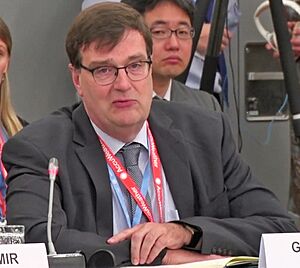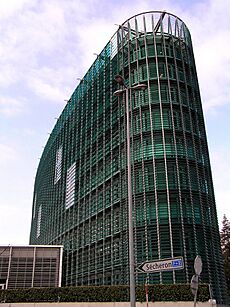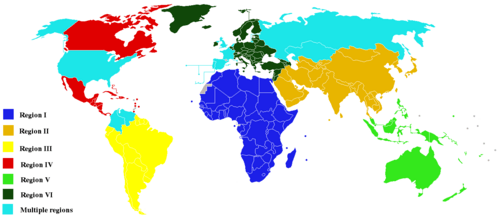World Meteorological Organization facts for kids
 |
|
| Abbreviation | WMO |
|---|---|
| Formation | 23 March 1950 |
| Type | United Nations specialized agency |
| Legal status | Active |
| Headquarters | Geneva, Switzerland |
|
Head
|
President Abdulla Al Mandous, UAE (since 2023) Secretary-General Celeste Saulo, Argentina since 2024 |
|
Parent organization
|
United Nations Economic and Social Council |
The World Meteorological Organization (WMO) is a special agency of the United Nations. It helps countries work together on weather, climate, and water science. The WMO makes sure that weather data and research are shared freely around the world. This helps everyone understand and prepare for weather events.
The WMO started from an older group called the International Meteorological Organization (IMO). This group began in 1873 to share weather information. In 1947, countries decided to create the WMO to make this cooperation even stronger. The WMO officially began its work on March 23, 1950. Since then, it has been an important part of the UN system.
Today, 193 countries and territories are members of the WMO. They share important information about weather and water. The WMO also works with other groups on topics like protecting the environment and understanding climate change. Its main office is in Geneva, Switzerland.
Contents
How the WMO Works
The WMO was created by a special agreement called the Convention of the World Meteorological Organization. This agreement was signed in 1947 and started on March 23, 1950. It explains what the WMO does and how it is run.
The WMO has a few main parts:
- The World Meteorological Congress is the top group. It decides the WMO's main goals and plans. Representatives from each member country meet every four years. They choose the President, Vice-Presidents, and members of the Executive Council. They also appoint the Secretary-General.
- The Executive Council helps carry out the decisions made by the Congress.
- The Secretariat is like the WMO's daily operations team. It has about 200 staff members and is led by the Secretary-General. The Secretary-General can serve for a maximum of two four-year terms.
The WMO publishes a yearly report called the "WMO Statement on the Status of the World Climate." This report shares details about global and local temperatures. It also talks about extreme weather events. The report includes information on long-term climate changes. These changes include greenhouse gases in the air, rising sea levels, and shrinking sea ice. For example, the year 2016 was recorded as the hottest year at that time.
As of August 2023, the WMO has 193 members. These include 187 countries and 6 territories.
Leaders of the WMO
The WMO has had several Secretary-Generals over the years. They lead the daily work of the organization.
- 1952–1955 Gustav Swoboda (
 Switzerland)
Switzerland) - 1956–1979 David Arthur Davies (
 United Kingdom)
United Kingdom) - 1980–1983 Aksel C. Wiin-Nielsen (
 Denmark)
Denmark) - 1984–2003 Godwin Obasi (
 Nigeria)
Nigeria) - 2004–2015 Michel Jarraud (
 France)
France) - 2016–2023 Petteri Taalas (
 Finland)
Finland) - 2024–present Celeste Saulo (
 Argentina)
Argentina)
WMO's Main Goals
The WMO has a plan to guide its work. Here are some of its key focus areas:
- Reducing Disaster Risks: Helping countries prepare for and deal with natural disasters.
- Climate Services: Providing useful climate information to help people make decisions.
- Observing Systems: Improving how we watch and collect data about the Earth's weather and climate.
- Aviation Weather: Making sure pilots and airlines have good weather information for safe flights.
- Polar and Mountain Regions: Focusing on the unique weather challenges in these important areas.
- Building Capacity: Helping countries develop their own weather and climate skills.
- Good Governance: Ensuring the WMO is run well and fairly.
Sharing Weather Data
The WMO helps create common ways to share weather, ocean, and water data. This means that weather stations all over the world can understand each other's information. Older ways of sharing data used special codes based on characters. Newer ways are more flexible and can be used for many different types of data.
Awards and Recognition
In 2007, a group called the Intergovernmental Panel on Climate Change (IPCC) won the Nobel Peace Prize. The IPCC was created by the WMO and the United Nations Environment Programme (UNEP). They won the prize for helping people learn more about human-caused climate change. They also helped set the stage for actions needed to fight climate change.
World Meteorological Day
Every year on March 23, people celebrate World Meteorological Day. This day marks the date when the WMO officially started.
Measuring Weather: Units Used
The WMO suggests using the International System of Units (SI) for weather measurements. This helps make sure everyone uses the same measurements. Here are some common units recommended by the WMO:
- Temperature: Degrees Celsius (°C) or Kelvin (K).
- Wind Speed: Metres per second (m/s).
- Wind Direction: Degrees clockwise from north (°). For example, 90 degrees is from the east.
- Air Pressure: Hectopascals (hPa).
- Humidity: Percent (%).
- Rainfall: Millimetres (mm).
- Sunshine: Hours (h).
- Visibility: Metres (m).
- Cloud Height: Metres (m).
- Cloud Cover: Oktas (a measure of how much of the sky is covered by clouds).
WMO Publications
The WMO creates many materials to share information with the public. These include:
- "The World Meteorological Organization at a Glance"
- "WMO for Youth"
- "WMO Bulletin" (published twice a year)
- "WMO Greenhouse Gas Bulletin" (published yearly)
- "WMO Statements on the Status of the World Climate" (published yearly)
- In September 2020, the WMO also published the United in Science 2020 Report. This report brought together the latest climate science from many different organizations.
WMO Awards
The WMO also gives out awards to recognize important work in meteorology:
- International Meteorological Organization Prize
- Professor Dr Vilho Väisälä Awards
- WMO Research Award for Young Scientists
- Professor Mariolopoulus Award
WMO Members Around the World
The WMO has members from all over the globe. These members are grouped into six regional associations. This helps them work together on weather issues specific to their areas.
Regional Association I (Africa)
This region includes countries in Africa. It has 57 member states.
- Algeria
- Angola
- Benin
- Botswana
- Burkina Faso
- Burundi
- Cameroon
- Cape Verde
- Central African Republic
- Chad
- Comoros
- Republic of the Congo
- Côte d'Ivoire
- Democratic Republic of the Congo
- Djibouti
- Egypt
- Eritrea
- Eswatini
- Ethiopia
- France
- Gabon
- The Gambia
- Ghana
- Guinea
- Guinea-Bissau
- Kenya
- Lesotho
- Liberia
- Libya
- Madagascar
- Malawi
- Mali
- Mauritania
- Mauritius
- Morocco
- Mozambique
- Namibia
- Niger
- Nigeria
- Portugal
- Rwanda
- São Tomé and Príncipe
- Senegal
- Seychelles
- Sierra Leone
- Somalia
- South Africa
- South Sudan
- Spain
- Sudan
- Tanzania, United Republic of
- Togo
- Tunisia
- Uganda
- Zambia
- Zimbabwe
Regional Association II (Asia)
This region covers countries in Asia. It has 33 member states and 2 member territories.
- Afghanistan
- Bahrain
- Bangladesh
- Bhutan
- Cambodia
- People's Republic of China
- India
- Iran, Islamic Republic of
- Iraq
- Japan
- Kazakhstan
- Kuwait
- Kyrgyzstan
- Lao People's Democratic Republic
- Maldives
- Mongolia
- Myanmar
- Nepal
- Democratic People's Republic of Korea
- Oman
- Pakistan
- Qatar
- Russian Federation
- Saudi Arabia
- Republic of Korea
- Sri Lanka
- Tajikistan
- Thailand
- Turkmenistan
- United Arab Emirates
- Uzbekistan
- Viet Nam
- Yemen
The member territories are:
- Hong Kong
- Macau
Regional Association III (South America)
This region includes countries in South America. It has 13 member states.
- Argentina
- Bolivia
- Brazil
- Chile
- Colombia
- Ecuador
- French Guiana
- Guyana
- Paraguay
- Peru
- Suriname
- Uruguay
- Venezuela
Regional Association IV (North America, Central America and the Caribbean)
This region covers North America, Central America, and the Caribbean. It has 25 member states and 2 member territories.
- Antigua and Barbuda
- Bahamas
- Barbados
- Belize
- Canada
- Colombia
- Costa Rica
- Cuba
- Dominica
- Dominican Republic
- El Salvador
- France
- Guatemala
- Haiti
- Honduras
- Jamaica
- Mexico
- Netherlands
- Nicaragua
- Panama
- Saint Lucia
- Trinidad and Tobago
- United Kingdom of Great Britain and Northern Ireland
- United States of America
- Venezuela
The two member territories are:
- British Caribbean Territories
- Curaçao and Sint Maarten
Regional Association V (South-West Pacific)
This region includes countries in the South-West Pacific. It has 23 member states and 2 member territories.
- Australia
- Brunei Darussalam
- Cook Islands
- Fiji
- Indonesia
- Kiribati
- Malaysia
- Federated States of Micronesia
- Nauru
- New Zealand
- Niue
- Papua New Guinea
- Philippines
- Samoa
- Singapore
- Solomon Islands
- Timor-Leste
- Tonga
- Tuvalu
- United Kingdom of Great Britain and Northern Ireland
- United States of America
- Vanuatu
The member territories are:
- French Polynesia
- New Caledonia
Regional Association VI (Europe)
This region covers countries in Europe and some parts of Western Asia. It has 50 member states.
- Albania
- Andorra
- Armenia
- Austria
- Azerbaijan
- Belarus
- Belgium
- Bosnia and Herzegovina
- Bulgaria
- Croatia
- Cyprus
- Czech Republic
- Denmark
- Estonia
- Finland
- France
- Georgia
- Germany
- Greece
- Hungary
- Iceland
- Ireland
- Israel
- Italy
- Jordan
- Kazakhstan
- Latvia
- Lebanon
- Lithuania
- Luxembourg
- Malta
- Monaco
- Montenegro
- Netherlands
- North Macedonia
- Norway
- Poland
- Portugal
- Romania
- Republic of Moldova
- Russian Federation
- Serbia
- Slovakia
- Slovenia
- Spain
- Sweden
- Switzerland
- Syrian Arab Republic
- Turkey
- Ukraine
- United Kingdom of Great Britain and Northern Ireland
Countries in More Than One Region
Some countries are members of more than one WMO region. This helps them work on weather issues that cross regional borders.
- France (Regions I, III, IV, and VI)
- United Kingdom (Regions I, IV, V, and VI)
- Colombia (Regions III and IV)
- Kazakhstan (Regions II and VI)
- Netherlands (Regions IV and VI)
- Portugal (Regions I and VI)
- Russia (Regions II and VI)
- Spain (Regions I and VI)
- United States (Regions IV and V)
- Venezuela (Regions III and IV)
See also
 In Spanish: Organización Meteorológica Mundial para niños
In Spanish: Organización Meteorológica Mundial para niños
- Cloud atlas
- International Cloud Atlas
- Regional Specialized Meteorological Centre




